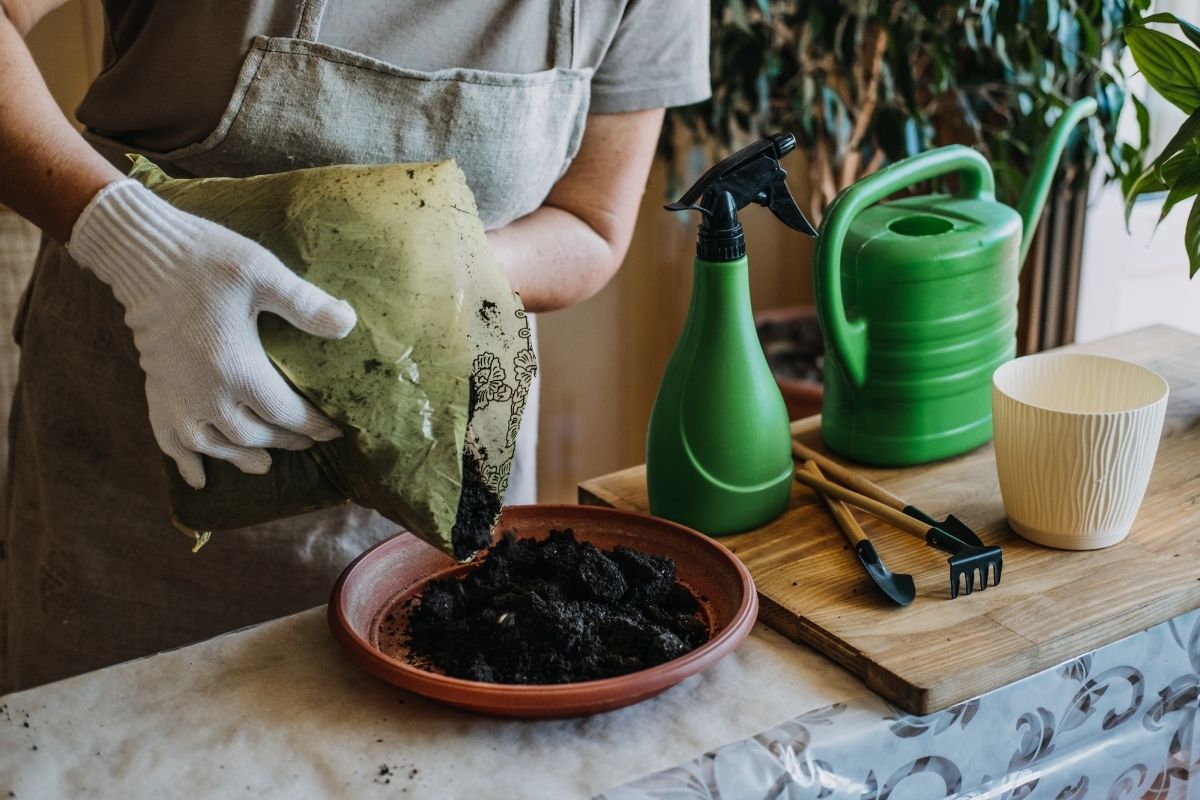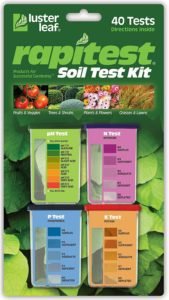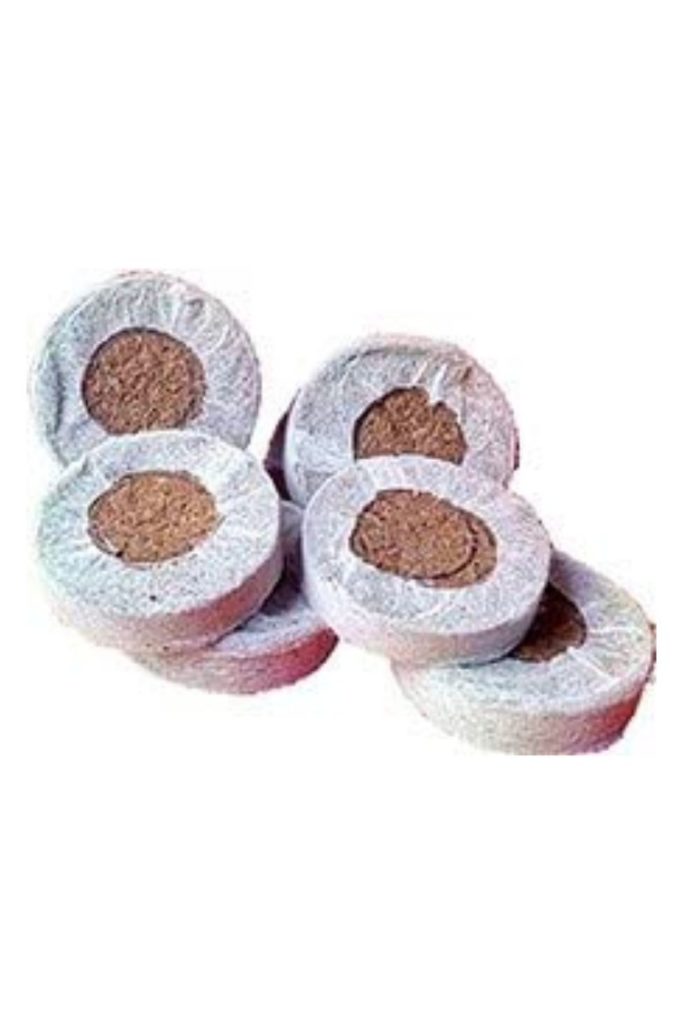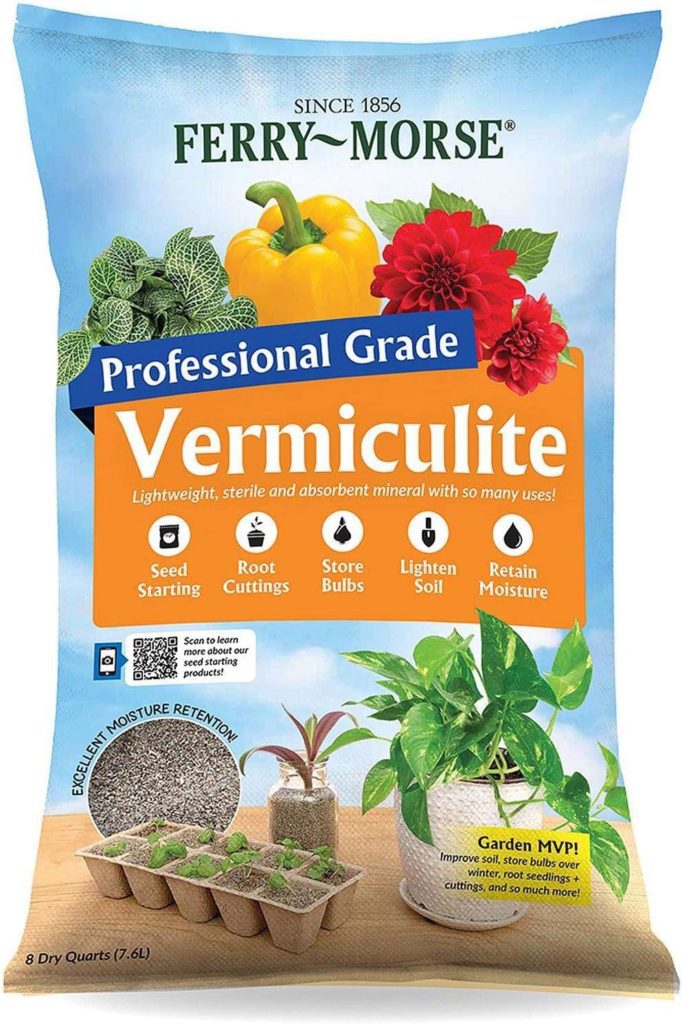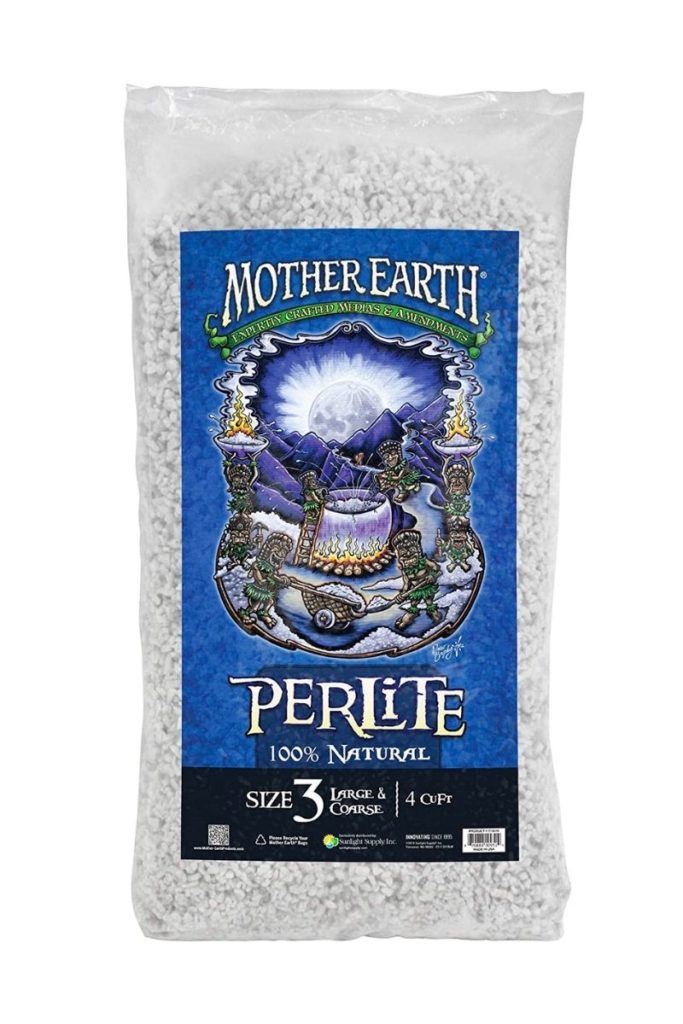Key takeaways:
- Soil is both more valuable and abundant than diamonds, and there are over 12 types of soil that occur naturally on earth.
- Soil is essential to support life on earth, and all food and production materials originate from soil.
- The specific materials present in any location define which nutrients and moisture plants receive in that environment.
- Soil texture is an important consideration for indoor gardeners, with four main categories: clay, sand, silt, and loam, each of which has its own benefits and drawbacks for plant growth.
Here’s a riddle for you: What material on Earth is both more valuable and more abundant than diamonds? 💎
Soil, of course!!
But did you know there are more than 12 types of soil that occur organically on this planet, according to the USDA? Yes, it’s true!
Some types of soil are better suited to supporting plant life than others, but all are vital to supporting life on this planet. Almost all of our food and production materials originate in soil. Soil conditions our atmosphere by absorbing carbon and giving life to vegetation, and without it, Earthlings, lifeforms and even your houseplants cannot survive.
In this article, we’ll go beyond the ‘garden variety’ definition of soil and examine soil as citizen scientists! 🤓 Get ready to transform your understanding of dirt and understand it on the deeper level, analyzing nutrient content, texture, organic material, and yes, biochemistry! Yes – you’ll learn about the specific qualities and benefits of single-ingredient soil conditioners. And yes, there will be a cool triangular graph!
At the end of the day, plants, like soils, are products of their natural environment. Understanding the types of naturally occurring soil on this planet will help you choose the best potting soil for your houseplants to keep them healthy and happy from the ground up 😁
More of a DIYer? The know-how in this article will equip you to mix up potting soil tailor-made for your houseplants, that’s waaay better than anything you can buy in the store.
Let’s dig in.
What is soil?
Back to basics! Soil is a complex mixture of fine stone particles, water, air, organic matter, and living organisms like bacteria and fungi. Much of the solid matter of soil is actually decaying and decomposed material, which provides the nourishment that plants need to grow.
The specific materials (including animal and plant life, minerals, and water) present in any location define which nutrients and how much moisture plants receive in that environment.
Soil also provides structural support for plants to anchor themselves in place. Plants like trees, woody brush, and grass have robust root systems for substantial nutrient and moisture storage, but many tropical plants (which include many of the most popular indoor plants), have finger roots that are used to plentiful nutrients from rich soils in diverse ecosystems. Both the quantity and quality of soil affects how the plant forms and what conditions it’s used to.
Types of soil
There are many types of soil across the world, and each location has its own unique environmental and biological history that affects the local soil profile. The United Nations’ Food and Agriculture Organization has a naming system that identifies about 30 types of soil across the world, while the USDA Soil Taxonomy identifies 12 types.
These are broken into subgroups as the definition becomes localized, resulting in thousands of different types of soil. The combinations are based on parent material, topography, climate, plant hardiness zone, and organic matter.
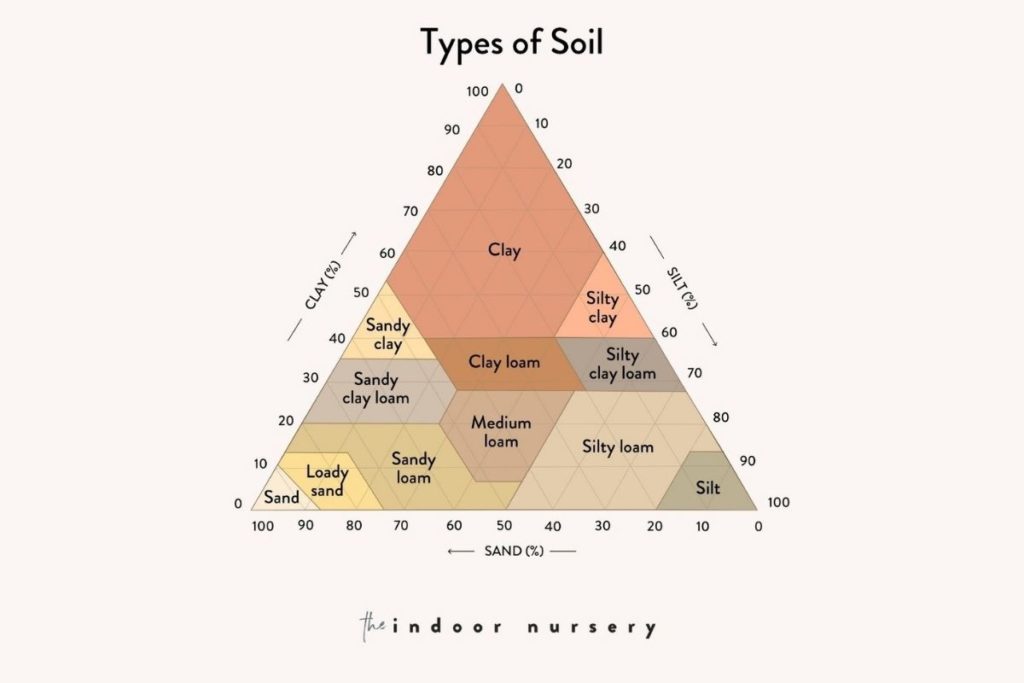
This doesn’t mean that your potting soil needs to be that specific, though! When you purchase potting soil, or the components to mix your own, the products will be calibrated for use on houseplants. A more useful, and simple, metric for indoor gardeners to monitor than USDA soil type is the texture of the soil.
Soil texture
Ok plant people! When plant scientists talk soil texture, they’re typically referring to what normal people think of when you describe texture (dense, loose, compacted, etc.) in the context of four broad categories of soil.
The scientific definition of soil texture is directly related to soil fertility, which is kind of a measure of how easy it is to grow something in the soil. As you might already know, dense and compacted soil is difficult for roots to grow in, while soil that is too porous and aerated won’t hold on to moisture or nutrient-rich matter. Soil texture is generally divided into four categories:
- Clay
- Sand
- Silt
- Loam
You can think of these categories as a shorthand for types of soil – just know that a plant or environmental scientist might correct you if you do!
Clay
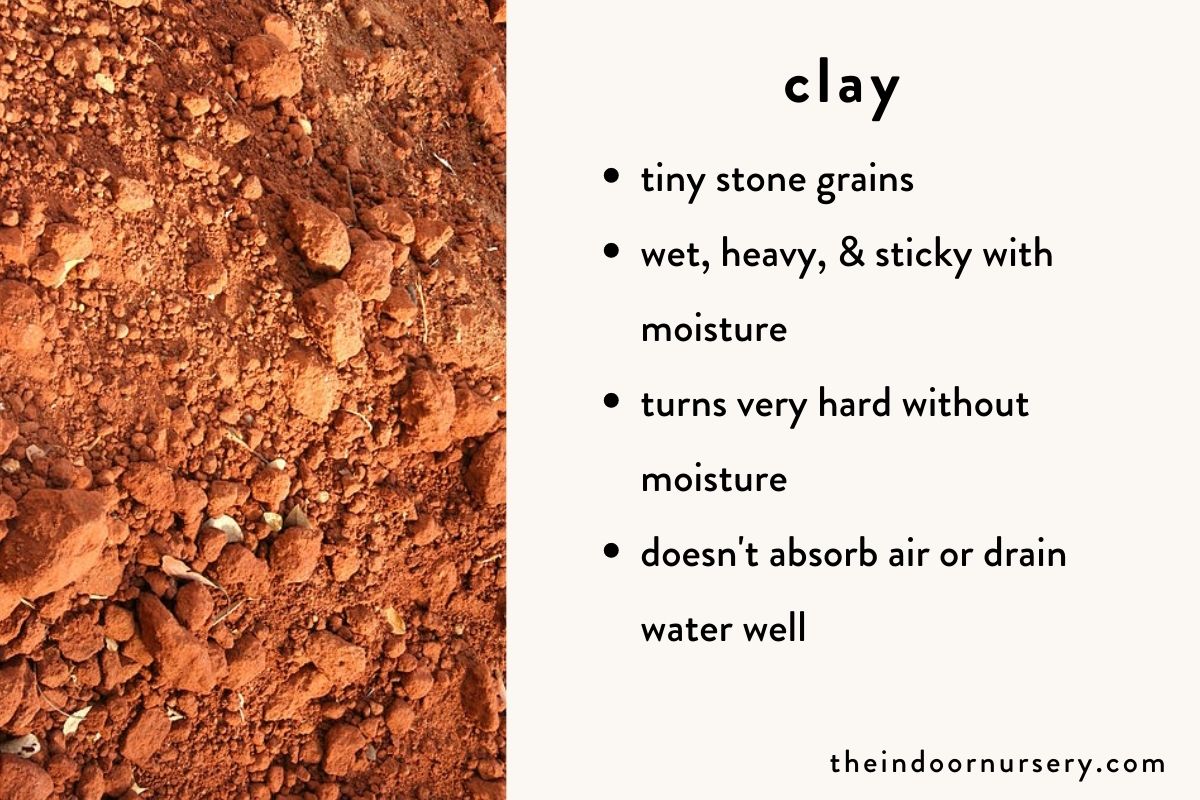
Clay soil is made of very tiny stone grains, and it gets wet, heavy, and sticky when it receives moisture. Without moisture, clay soil gets very hard (an advantageous quality for making ceramics, but not so ideal when trying to grow seeds).
Whether wet or dry, clay soils tend to be impermeable and don’t absorb air or drain water well. When there’s too much clay in soil, plants struggle to establish root systems in the dense material, but in moderate amounts, clay is a great moisture retainer for plants that don’t like to dry out too quickly.
Sand
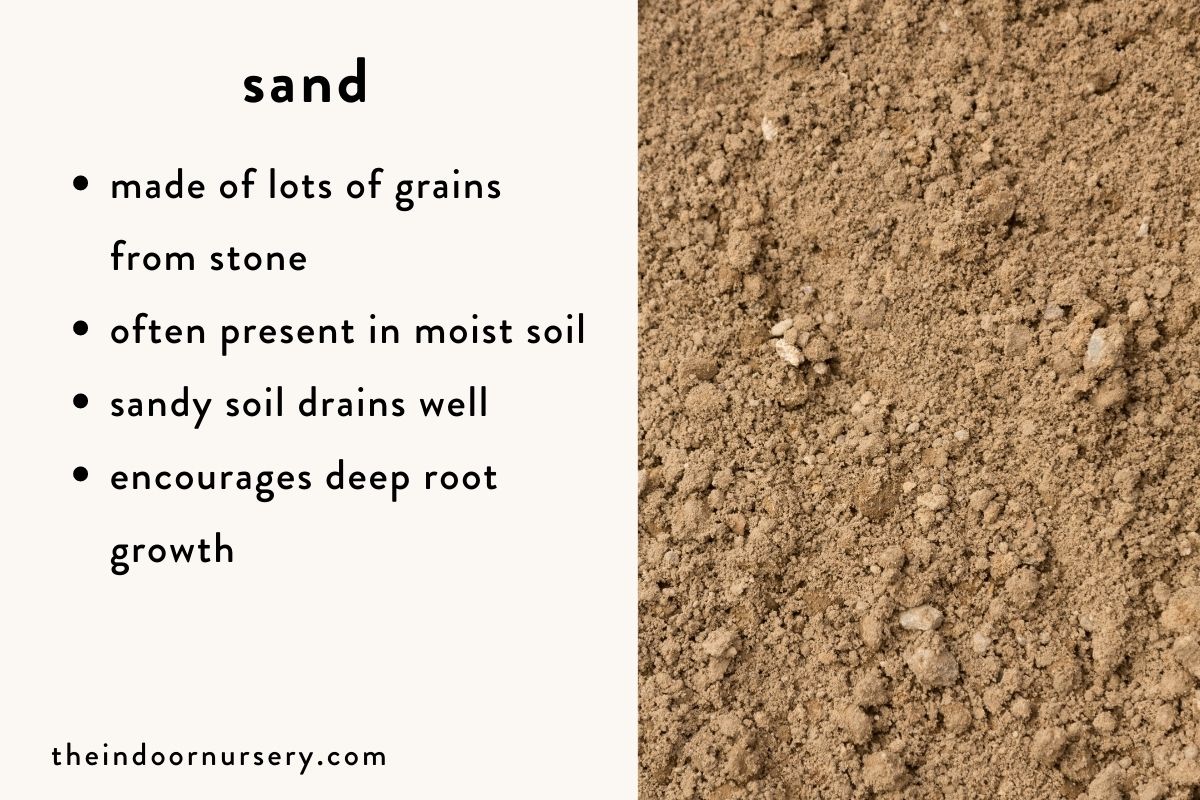
Sand is made of lots of gains of stone and stone-like materials broken off of larger rocks in the topsoil, mineral strata in the ground, or sea creature shells that have eroded over time. Sand is often present in moist soil in some quantity, especially in coastal areas. Sandy soil drains well and encourages deep root growth in the plants that grow in it. Too much sand, however, can make the soil dry out too quickly.
Silt
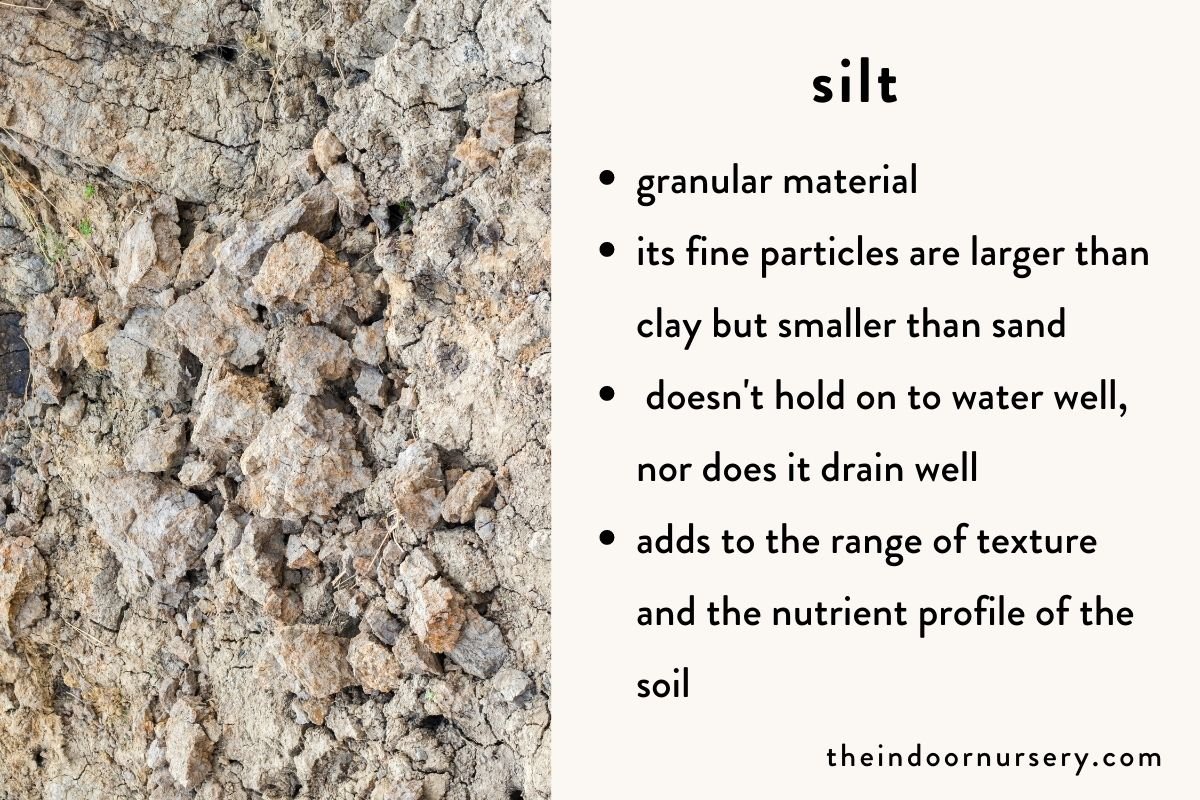
So far so good? Most gardeners have heard of clay and sand, but you might not have heard of silt. Silt is a granular material whose fine particles are larger than clay but smaller than sand. Silty soil is nutrient-dense sediment found in and along rivers and river basins. The fine material doesn’t provide much structure and can get washed away easily.
It neither holds on to water well, nor does it drain well. When present in a mix of clay or sand, however, silt soil adds to the range of texture and the nutrient profile of the soil, and for these reasons, is a valuable material.
Loam
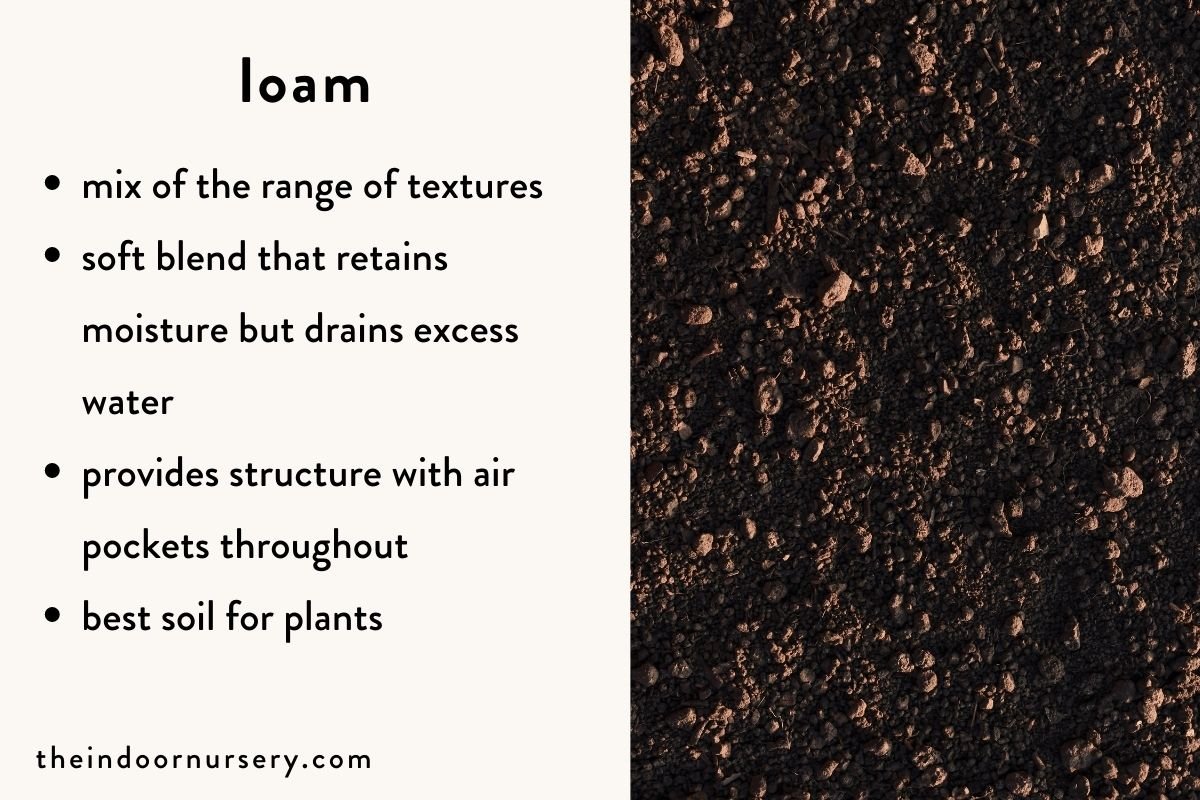
Loamy soil is a mix of the range of textures. It’s a soft blend that retains moisture but drains excess water, providing structure that also has small pockets of air throughout it, in which roots can grow and breathe. Loamy soils are the best kind for plants, and are usually darker in color than sand or clay.
Organic material and nutrient content in soil
Many people are surprised by the quantity of rock in most types of soil when first taking a closer look. After all, the organic material present in soil is what provides the nutrients that enable plant growth. However, the fine stone base in sand, clay, and silt provides solid structure that stabilizes the organic material on both a structural and chemical level, affecting the air and moisture content.
Organic material in soil includes moss, decaying plants, and humus (organic matter decomposed by worms, bacteria, and other insects). In nature, plants grow in succession in the same place over and over, and as they shed leaves, blooms, or perhaps die at the end of the growing season, the plant material they drop breaks down into the soil, and nutrients are returned to the soil to be absorbed again. That’s the cycle of life in a nutshell folks!
Topsoil
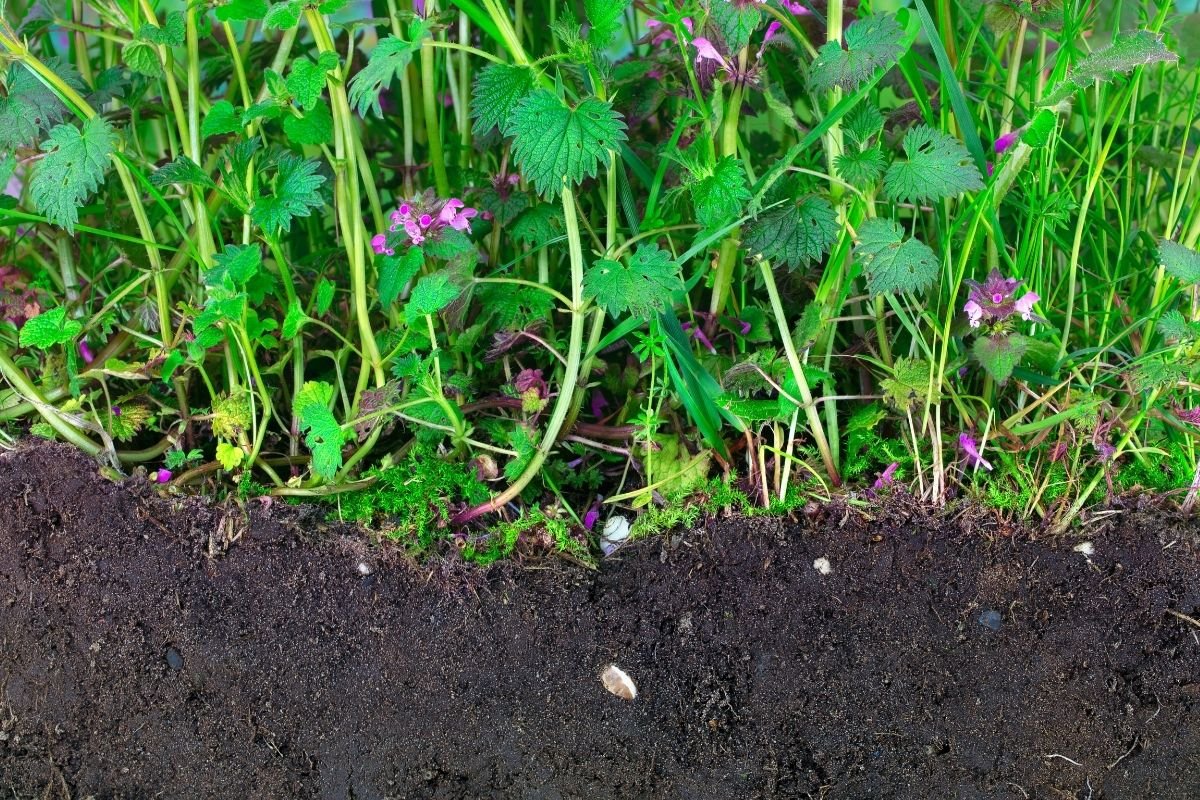
The soil’s surface is the most nutrient-rich layer of soil, what with all of this seasonal shedding, death, and rebirth happening. The upper 5-10 inches of ground (yep, less than a foot) is known as topsoil. This is the zone where organic nutrients are broken down and then absorbed by plants, and it’s the ‘happy place’ where most plant roots tend to spread in search of nutrients and moisture.
The topsoil is also well-aerated since it’s the first layer of the ground to filter nutrients from rainwater, and it’s also the first layer to dry out from exposure to air and sunlight. Very sandy soils, however, encourage deep roots in certain environments, especially in some grasses.
Subsoil
Below topsoil, you’ll find subsoil (also known as “undersoil” or “B soil horizon” to get technical about it). This soil layer is typically right below the topsoil, below the root zone of most plants. Subsoil can form a layer anywhere from a few inches to up to a foot thick and is home to earthworms, beetles, grubs, and microbes.
This layer of soil accumulates minerals and is typically composed of a mixture of clay, silt, and sand that compacts under the weight of the topsoil and without the aeration created by tunneling roots and surface decomposition. Subsoil typically stores excess moisture from heavy rain, and releases it back to the topsoil during periods of drought.
Bedrock
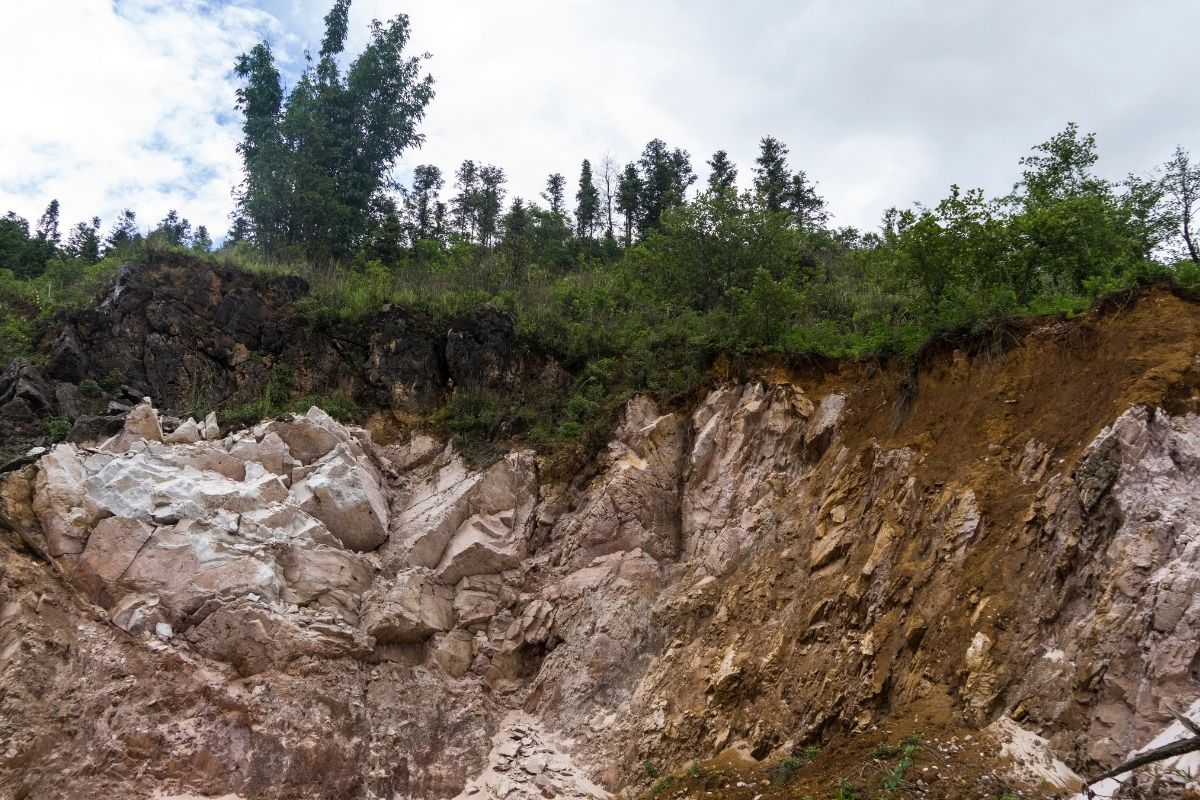
Below the subsoil is a layer where compressed, unabsorbed soil material starts to reach bedrock, from which much of the mineral base of soil is drawn as it naturally breaks down and gets moved around. The subsurface mixing of bedrock and organic material influences the texture of the soil from the bottom up, and the climactic effects (weather-related) and environmental effects (presence of vegetation, animals, and people) contribute to the composition of the soil from the top down.
Soil amendments
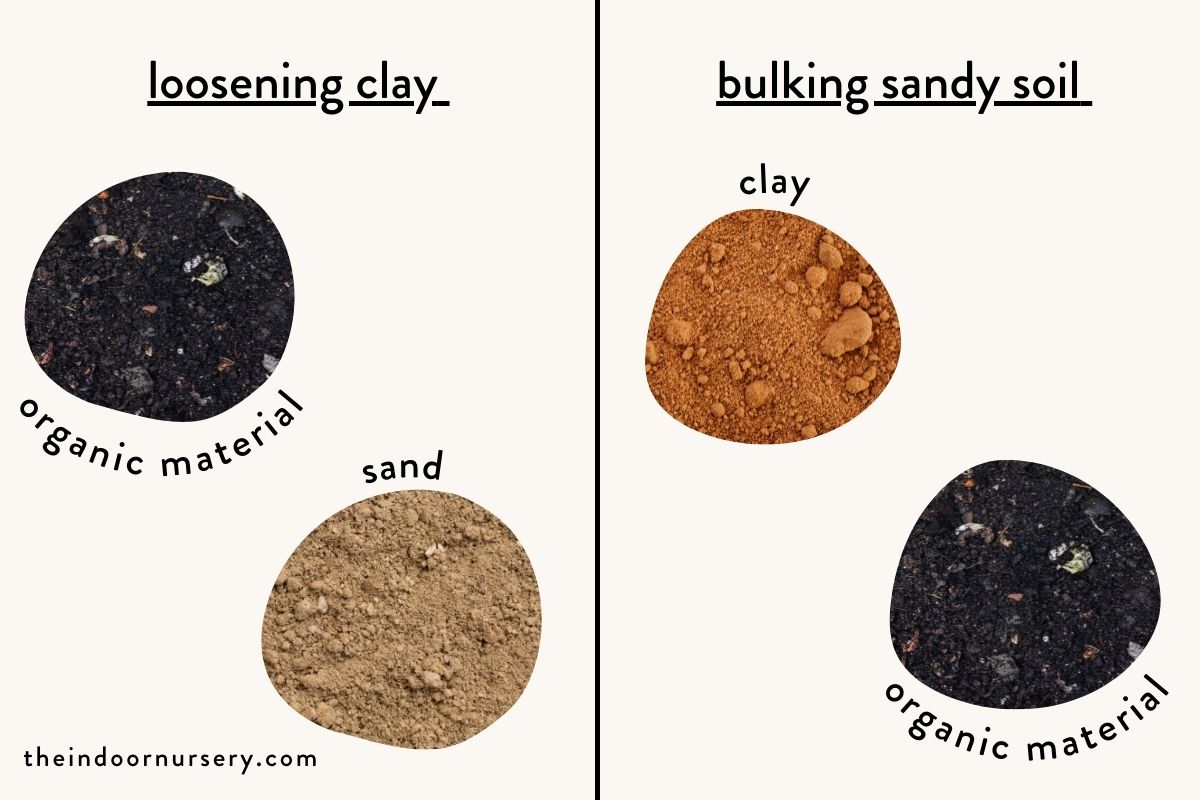
Adding compost, fertilizer, worm castings, and other organic material to depleted soils helps to both build quantity and improve the quality.
Clay soils, for example, need to be loosened up with organic matter and sand, which work their way between the fine grains of clay to break it into smaller particles, allowing nutrients and oxygen to permeate, and to increase drainage. Sandy soil, on the other hand, needs to be bulked up with organic material, as well as clay, both of which help it retain moisture.
Soil acidity
Both the organic and inorganic materials present in the soil affect the pH level of soil. The pH, or potential of hydrogen, affects whether certain nutrients are available for uptake by plant roots or not, and it’s measured on a scale of 1-14.
Any pH below 7 is considered acidic, and any pH above 7 is considered alkaline (or basic). When organic material decomposes, the soil acidity increases as a byproduct of the decomposition process. It’s actually really easy to test your soil pH with the right equipment and a bit of determination.
Most plants thrive best in a pH range between 5.5-6.5 – so some acidity can be good. This is especially true for plants that are used to active topsoil where decomp creates a more acidic environment, or those that are from places that get a lot of rain (which contains acidic compounds from atmospheric gasses, like nitrogen and sulfur). Wetlands tend to be particularly acidic, and peat procured from bogs will raise soil acidity as it breaks down when used as an additive.
The bedrock itself also affects the soil acidity in the layers above it: Places that have limestone or chalk (a type of limestone) have more alkaline soils. Desert areas with little rainfall and low topsoil levels will also have lower acidity levels.
Soil products
Truth be told, it’s a little wild out there when it comes to choosing soil. When you purchase soil to use for your indoor plants, you’ll find there are TONS of options. It’s important to choose carefully since different soil products are formulated for different uses.
Bagged topsoil that’s meant to be used outdoors usually doesn’t contain organic matter but is mostly sand, clay, and silt to mix into and increase the bulk of soil on the ground. Garden soil, in contrast, will include wood products and peat moss, in addition to the topsoil base. These soil types are not well-aerated and aren’t meant to be used indoors. They will become too wet and won’t be able to drain properly.
Potting mix, on the other hand, is meant to be used for plants grown in containers, both outside and indoors. These products will include a topsoil base with organic material like wood products, peat moss, and/or coco coir, as well as drainage support like perlite, vermiculite, or other coarse materials like sand or fine gravel.
These potting soil mixtures retain moisture and drain excess water, allowing for aeration and consistent moisture availability. They also usually include some slow-release granular or organic fertilizer to deliver even more nutrients than untreated soil.
The nutrient profile and material combination will vary by product. For plants like cacti, succulents, and aloe, soils are designed to drain well with lower organic material amounts. Other plants, like monstera, pothos, and dracaena, will like moisture-retaining mixtures that have more organic material. Flowering plants and vegetables like a different nutrient balance than non-flowering plants, and specific formulas will cater to their needs.
FAQs
can I use soil from outdoors for my potted plants?
Don’t use soil from outside to pot your plants! When you take soil from your backyard or a nearby park, that soil will be full of insects and weed seeds. It also won’t be as nutrient-dense as specially formulated potting soils are. Chances are that soil isn’t the kind of soil your indoor plant is used to in its native environment. Be sure to match the soil profile to the plant!
can I reuse old soil?
Yes, you can amend and condition your old soil to keep it in use! In nature, soil remains robust with a regular supply of matter from the environment. When you fertilize, adjust the pH, or add bulky organic matter as the quantity depletes, you’re conditioning the soil from the top-down. If you want to totally refresh the plant’s soil, the best time to do it is when you’re transferring a plant to a new pot.
how do plants grow without soil?
There are some methods that allow you to grow plants without soil. In nature, very few plants can grow without at least some soil (including moss and lichens). Humans can grow plants without soil, however, when we use hydroponic or semi-hydroponic systems and provide nutrients to the plant roots with fertilized water.
Products labeled ‘soilless soil’ contain zero organic material and offer a “clean”, easy to maintain, and (sometimes) eco-friendly alternative to organic-matter-containing potting mixes. The tradeoff is that you need to monitor and add nutrients in the form of fertilizer more regularly than in soil-based mixtures.
more about soil
- How to Use Leca for Plants: Step-by-Step Guide with Pictures
- Best Soil For Snake Plants That Will Keep Them Happy
- The Best pH Meter For Soil
- The Best Soil For Indoor Plants (Every Kind Of Plant)
- The Best LECA Balls (Expanded Clay Pebbles) For Your Plants
- 8 Best Soil Moisture Meter Options For Indoor Plants
- Best Soil For Monstera Plants (DIY Recipe + Store-Bought Options)
- How to Make Potting Soil for Indoor Plants, Plus My Secret Ingredient
- Is that mold on plant soil? Here’s what you need to know.
- How to use a moss pole for plants: An expert explains
- Tags:
- Soil

